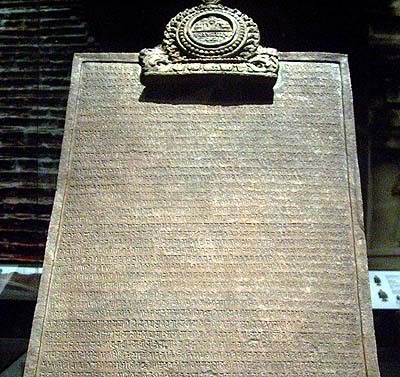The Nalanda Copperplate was issued by a king of Bengal named Devapaladeva in 860 CE. Written in Devanagari and proto-Bengali, the script constitutes a request from a king of Suvarnadvipa named Balaputradeva to build a monastery in Nalanda, where king Devapaladeva offered five villages to maintain the monastery and support the students.

The quotations of Nalanda Copperplate are as follows:
“… We being requested by the illustrious Maharaja Balaputradeva, the king of Suvarnadvipa through a messenger I have caused to be built a monastery at Nalanda granted by this edict toward the income for the blessed Lord Buddha, the abode of all the leading virtues like the prajnaparamita, for the offerings, shelter, garments, alms, beds, the requisites of the sick like medicines, etc., of the assembly of the venerable bhiksus of the four quarters (comprising) the bodhisattvas well versed in the Tantras, and the eight great holy personages (aryapudgalas) for writing the dharma-ratna of Buddhist texts and for the up-keep and repair of the monastery when damaged …”
“With the mind attracted by the manifold excellences of Nalanda and through devotion to the son of Suddhodana and having realized that riches was fickle like bubbles of a mountain stream, he whose fame was like that of Sangharthamitra … that his wealth befriended the cause of the Sangha. Built there (at Nalanda) a monastery which was the abode of the assembly of monks of various good qualities and was white with the series of stuccoed and lofty dwellings. Having requested, King Devapaladeva … through envoys, very respectfully and out of devotion and issuing a charter, granting these five villages whose purpose had been described above, for the welfare of himself, his parents and the world …”
“… As long as there is continuance of the ocean, or the Ganges has her limbs agitated by the extensive plaited hair of Siva, as long as the immovable King of Snakes lightly bears the heavy and extensive earth every day, and as long as Eastern (Udaya) and Western (Asta) mountains have their crest jewels scratched by the hoofs of the horses of the sun, so long may this meritorious act, setting up virtues over the world, endure …”
From the copperplate it is evident that at the time there existed close relationships of religion and politics between Srivijaya and the Palas of India. The relationships also further expanded in the field of trades and education.
 Bahasa
Bahasa
 December 11th, 2010
December 11th, 2010  SUDIMUJA
SUDIMUJA  Posted in
Posted in